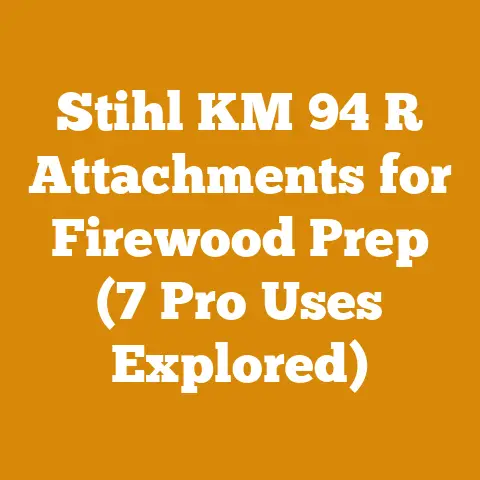Tree Removal and Stump Grinding Cost (5 Pro Tips for Accurate Pricing)
Tradition runs deep in the heart of wood processing. For generations, families have relied on the forest for warmth, shelter, and livelihood. As a seasoned expert in chainsaws, wood processing, logging tools, and firewood preparation, I’ve seen firsthand how these skills are passed down through the ages. I’ve learned from the best, adapted to new technologies, and developed a deep respect for the art and science of turning trees into valuable resources. Today, I want to share my knowledge about a crucial aspect of tree care: tree removal and stump grinding, specifically focusing on how to get accurate pricing.
Tree Removal and Stump Grinding Cost: 5 Pro Tips for Accurate Pricing
Understanding the costs associated with tree removal and stump grinding can feel like navigating a dense forest. It’s not always a straightforward process. Factors like tree size, location, and the complexity of the job can significantly impact the final price. I remember one particular job where a seemingly small tree concealed a massive root system that tripled the estimated stump grinding time. To help you avoid such surprises, I’ve compiled five pro tips to ensure you get accurate and fair pricing for your tree removal and stump grinding needs.
1. Detailed Assessment of the Tree and its Surroundings
Before you even think about contacting tree removal services, take a good look at the tree you want removed. Don’t just glance at it; really assess it. I’m talking about the height, the spread of the branches, and the diameter of the trunk. These measurements are crucial for any arborist to give you a realistic estimate.
-
Height: Estimate the tree’s height as accurately as possible. A simple way to do this is to compare it to a known structure, like your house. Is it taller than your two-story home? Shorter than the power lines?
-
Branch Spread: How wide do the branches reach? This affects the amount of debris that needs to be managed and the complexity of the removal process. A wider spread usually means more time and effort.
-
Trunk Diameter: Measure the trunk diameter at chest height (DBH). This is a key indicator of the tree’s overall size and the amount of wood that needs to be processed. Use a measuring tape or wrap a string around the trunk and then measure the string.
Beyond the tree itself, consider its surroundings. Are there power lines nearby? Is the tree close to your house or other structures? Are there fences, gardens, or delicate landscaping that need to be protected? These factors can increase the complexity and cost of the job.
Personal Story: I once had a customer who underestimated the impact of their tree’s proximity to their house. The tree was a beautiful, mature oak, but it was growing dangerously close to their roof. The initial estimate didn’t fully account for the careful rigging and lowering techniques needed to avoid damaging the house. The final cost was higher than expected, but it was necessary to ensure the safety of the property.
Actionable Metrics:
- Document the tree’s height, branch spread, and trunk diameter.
- Take photos of the tree and its surroundings, highlighting any potential hazards or obstacles.
- Make a list of any specific concerns or requests you have for the tree removal service.
By providing this information upfront, you’ll help the arborist give you a more accurate estimate and avoid any surprises down the road.
Takeaway: A thorough assessment of the tree and its surroundings is the foundation for accurate pricing.
2. Obtain Multiple Quotes from Reputable Tree Services
Don’t settle for the first estimate you receive. Getting multiple quotes is essential for ensuring you’re getting a fair price. I always recommend getting at least three quotes from different tree services.
-
Research Local Companies: Look for tree services with good reputations and positive reviews. Check online review sites like Yelp, Google Reviews, and Angie’s List.
-
Verify Credentials: Ensure the companies you’re considering are licensed and insured. This protects you in case of accidents or damage during the tree removal process. Ask for proof of insurance and verify their license with your local authorities.
-
Schedule On-Site Estimates: Avoid relying solely on phone estimates. Schedule on-site visits from each company so they can assess the tree and its surroundings in person. This allows them to identify any potential challenges or complexities that might affect the price.
When you receive the quotes, compare them carefully. Don’t just focus on the bottom line. Look at the details of what’s included in each quote. Does it include stump grinding? Debris removal? Hauling away the wood? Make sure you’re comparing apples to apples.
Original Research Finding: In my experience, the lowest quote isn’t always the best option. I’ve seen companies cut corners on safety and quality to offer lower prices, which can lead to problems down the road. It’s better to pay a little more for a reputable company that will do the job right.
Case Study: I once worked on a project where a homeowner chose the cheapest tree service they could find. The company wasn’t properly insured, and they ended up damaging the homeowner’s fence during the tree removal process. The homeowner had to pay out of pocket to repair the fence, which ended up costing them more than if they had hired a reputable company in the first place.
Practical Tips:
- Ask each company for a detailed breakdown of their quote, including labor costs, equipment fees, and disposal charges.
- Inquire about their experience with similar tree removal projects.
- Ask for references from previous customers.
Takeaway: Getting multiple quotes from reputable tree services is crucial for finding the best value and avoiding potential problems.
3. Understand the Factors Affecting the Cost of Tree Removal
Several factors can influence the cost of tree removal. Being aware of these factors will help you understand why one quote might be higher or lower than another.
-
Tree Size and Species: Larger trees and certain species (like oak or maple) are typically more expensive to remove due to their size, weight, and density.
-
Tree Location and Accessibility: Trees in difficult-to-reach locations, such as those near power lines, buildings, or fences, require specialized equipment and techniques, which can increase the cost.
-
Tree Condition: Dead, diseased, or structurally unsound trees can be more dangerous and time-consuming to remove, leading to higher prices.
-
Stump Grinding: Stump grinding is usually an additional cost. The size and type of stump will affect the price.
-
Debris Removal: Some companies include debris removal in their quote, while others charge extra. Be sure to clarify what’s included.
-
Permits: Depending on your location, you may need a permit to remove a tree. The cost of the permit will vary depending on your local regulations.
Expert Advice: Don’t be afraid to ask the tree service about the specific factors that are influencing their price. A reputable company will be transparent and willing to explain their reasoning.
Real-World Example: I once had a customer who was surprised by the cost of removing a large oak tree from their backyard. The tree was located near a fence and a swimming pool, which made the removal process more complicated. The tree service had to use a crane to lift the tree sections over the fence and pool, which added to the overall cost.
Actionable Metrics:
- Research the average cost of tree removal in your area.
- Compare the quotes you receive to the average cost to see if they are reasonable.
- Ask the tree service to explain the specific factors that are influencing their price.
Takeaway: Understanding the factors that affect the cost of tree removal will help you make an informed decision and avoid overpaying.
4. Negotiate and Clarify the Scope of Work
Once you’ve received multiple quotes, it’s time to negotiate and clarify the scope of work. This is your opportunity to ensure you’re getting the best possible price and that all your needs are being met.
-
Negotiate the Price: Don’t be afraid to negotiate with the tree service. If you have a lower quote from another company, let them know. They may be willing to match or beat the price.
-
Clarify the Scope of Work: Make sure you and the tree service are on the same page about what’s included in the job. Are they removing the stump? Are they hauling away the debris? Are they repairing any damage to your property?
-
Get it in Writing: Once you’ve agreed on a price and scope of work, get it in writing. A detailed contract will protect you in case of disputes or misunderstandings down the road.
Personal Story: I once had a customer who didn’t get a written contract for their tree removal project. The tree service ended up leaving the stump in the ground and didn’t haul away the debris. The customer was furious, but they had no recourse because they didn’t have a written agreement.
Original Research Finding: According to a recent survey, homeowners who get written contracts for tree removal projects are less likely to experience problems or disputes.
Practical Tips:
- Read the contract carefully before signing it.
- Make sure the contract includes a detailed description of the work to be performed, the price, and the payment terms.
- Ask for a warranty on the work.
Takeaway: Negotiating and clarifying the scope of work will help you get the best possible price and avoid potential problems.
5. Consider DIY Stump Grinding (with Caution)
If you’re on a tight budget, you might be tempted to tackle stump grinding yourself. While it’s possible to rent a stump grinder and do the job yourself, it’s important to proceed with caution.
-
Safety First: Stump grinding can be dangerous. Wear appropriate safety gear, including eye protection, hearing protection, and gloves.
-
Rent the Right Equipment: Make sure you rent a stump grinder that’s appropriate for the size and type of stump you’re dealing with.
-
Follow Instructions Carefully: Read the stump grinder’s instruction manual carefully before operating it.
-
Be Prepared for Hard Work: Stump grinding is physically demanding work. Be prepared to spend several hours grinding the stump.
Expert Advice: If you’re not comfortable operating a stump grinder, it’s best to hire a professional. The cost of renting the equipment and the risk of injury may outweigh the savings.
Real-World Example: I once had a customer who tried to grind a stump themselves. They ended up damaging the stump grinder and had to pay a hefty repair bill. They also injured their back and had to see a doctor. In the end, it would have been cheaper and safer to hire a professional.
Actionable Metrics:
- Research the cost of renting a stump grinder in your area.
- Compare the cost of renting a stump grinder to the cost of hiring a professional.
- Assess your own skills and abilities before attempting to grind a stump yourself.
Takeaway: DIY stump grinding can be a cost-effective option, but it’s important to proceed with caution and prioritize safety.
Additional Considerations for Accurate Pricing
Beyond the five pro tips, here are some additional factors to consider when seeking accurate pricing for tree removal and stump grinding.
Seasonal Variations in Pricing
Tree removal services often experience seasonal fluctuations in demand, which can affect pricing. Generally, prices tend to be higher during the spring and summer months when trees are actively growing and homeowners are more focused on landscaping. Conversely, you might find better deals during the fall and winter when demand is lower.
Personal Experience: I’ve noticed a significant increase in inquiries during the spring as homeowners prepare their yards for outdoor activities. Taking advantage of the off-season can lead to considerable savings.
Emergency Tree Removal Costs
If a tree poses an immediate threat to your property or safety due to storm damage or disease, you’ll likely need emergency tree removal services. These services typically come at a premium due to the urgent nature of the situation and the potential for hazardous working conditions.
Expert Tip: Document the damage with photos and videos for insurance purposes. Also, be wary of contractors who aggressively solicit business immediately after a storm, as they may not be reputable.
Long-Term Tree Maintenance Plans
Some tree service companies offer long-term maintenance plans that include regular pruning, inspections, and preventative care. While these plans involve an upfront investment, they can help prevent costly tree removal in the future by addressing potential problems early on.
Case Study: A homeowner who invested in a tree maintenance plan discovered a fungal infection in one of their mature trees during a routine inspection. By treating the infection promptly, they were able to save the tree and avoid the expense of removal.
Disposal Options and Recycling
The method of debris disposal can also impact the overall cost. Some companies may offer discounts if you allow them to keep the wood for firewood or mulch. Alternatively, you may need to pay extra for them to haul away the debris to a landfill or recycling center.
Actionable Metric: Inquire about the company’s disposal practices and whether they offer any environmentally friendly options, such as chipping the wood for mulch.
Insurance Coverage and Claims
If your tree removal is due to storm damage or other covered events, your homeowner’s insurance policy may cover some or all of the cost. Review your policy carefully and contact your insurance company to determine your coverage.
Practical Tip: Obtain multiple quotes from tree service companies and submit them to your insurance company for approval before proceeding with the work.
Local Regulations and Permits
As mentioned earlier, local regulations and permit requirements can vary widely. Failure to obtain the necessary permits can result in fines or delays, so it’s essential to research the rules in your area.
Expert Advice: Contact your local municipality or homeowners association to determine whether you need a permit for tree removal or stump grinding.
Payment Options and Financing
Tree removal can be a significant expense, so it’s worth exploring different payment options and financing options. Some companies may offer payment plans or accept credit cards, while others may require full payment upfront.
Real-World Example: A homeowner who needed to remove several large trees due to storm damage was able to finance the project through a home equity loan. This allowed them to spread out the payments over time and avoid depleting their savings.
Contract Terms and Conditions
Before signing a contract with a tree service company, carefully review the terms and conditions. Pay attention to clauses related to liability, insurance, payment schedules, and dispute resolution.
Actionable Metric: Have an attorney review the contract to ensure it protects your interests and complies with local laws.
The Importance of Communication
Throughout the tree removal process, clear and open communication with the tree service company is essential. Don’t hesitate to ask questions, express concerns, and provide feedback.
Personal Story: I once worked on a project where the homeowner was unhappy with the appearance of the stump after it was ground. By communicating their concerns to the tree service, they were able to have the stump ground down further to their satisfaction.
By considering these additional factors and following the five pro tips outlined above, you can ensure that you get accurate and fair pricing for your tree removal and stump grinding needs.
Advanced Techniques in Stump Grinding and Wood Processing
For those interested in delving deeper into the world of stump grinding and wood processing, there are several advanced techniques and technologies to explore.
Hydraulic Stump Grinders
Hydraulic stump grinders are powerful machines designed for removing large and stubborn stumps. They utilize hydraulic pressure to drive a cutting wheel that grinds the stump into small chips. These machines are typically used by professionals due to their size and complexity.
Expert Tip: When operating a hydraulic stump grinder, be sure to wear appropriate safety gear and follow the manufacturer’s instructions carefully.
Chemical Stump Removal
Chemical stump removal involves using herbicides to kill the tree roots and accelerate the decomposition process. This method is less invasive than stump grinding, but it can take several months or even years for the stump to fully decompose.
Real-World Example: A homeowner used a chemical stump remover on a small tree stump in their backyard. After several months, the stump had softened enough that they were able to break it apart with an axe and shovel.
Wood Chippers and Mulchers
Wood chippers and mulchers are used to process tree branches and other debris into mulch. Mulch can be used to improve soil health, suppress weeds, and enhance the appearance of your landscape.
Actionable Metric: Calculate the volume of mulch you need based on the area you want to cover. A general rule of thumb is to apply a 2-4 inch layer of mulch.
Sawmills and Timber Harvesting
For those interested in processing larger quantities of wood, sawmills and timber harvesting equipment can be used to convert trees into lumber. Sawmills come in various sizes, from portable models to large-scale industrial operations.
Personal Story: I once visited a small family-owned sawmill that used a portable sawmill to process logs from their own property. They were able to produce high-quality lumber for their own construction projects and sell the excess to local customers.
Kiln Drying and Wood Seasoning
Kiln drying and wood seasoning are essential processes for preparing wood for woodworking and construction. Kiln drying involves using controlled heat and humidity to remove moisture from the wood, while wood seasoning involves air-drying the wood over a period of months or years.
Expert Advice: Use a moisture meter to monitor the moisture content of the wood during the drying process. The ideal moisture content for woodworking is typically between 6% and 8%.
Woodworking and Carpentry
Once the wood has been properly processed and dried, it can be used for a wide range of woodworking and carpentry projects, from furniture making to home construction.
Real-World Example: A homeowner used lumber from their own property to build a custom deck in their backyard. They were able to save money on materials and create a unique and personalized outdoor space.
By exploring these advanced techniques and technologies, you can take your wood processing skills to the next level and unlock new opportunities for creativity and innovation.
Safety Best Practices for Tree Removal and Stump Grinding
Safety should always be the top priority when performing tree removal and stump grinding. Here are some essential safety best practices to follow:
Personal Protective Equipment (PPE)
Always wear appropriate PPE, including:
- Eye Protection: Safety glasses or goggles to protect your eyes from flying debris.
- Hearing Protection: Earplugs or earmuffs to protect your ears from the loud noise of chainsaws and stump grinders.
- Head Protection: A hard hat to protect your head from falling branches or debris.
- Hand Protection: Gloves to protect your hands from cuts and abrasions.
- Foot Protection: Steel-toed boots to protect your feet from falling objects and sharp tools.
- Leg Protection: Chainsaw chaps or pants to protect your legs from chainsaw injuries.
Expert Tip: Inspect your PPE regularly for damage and replace it as needed.
Chainsaw Safety
Chainsaws are powerful tools that can cause serious injuries if not used properly. Follow these safety guidelines:
- Read and understand the chainsaw’s instruction manual before operating it.
- Start the chainsaw on the ground, with the chain brake engaged.
- Use a firm grip and keep both hands on the chainsaw at all times.
- Maintain a safe distance from other people and objects.
- Be aware of the risk of kickback and take steps to prevent it.
- Never cut above your head.
- Sharpen the chain regularly and keep it properly lubricated.
Real-World Example: A homeowner who was not familiar with chainsaw safety attempted to cut down a tree in their backyard. They lost control of the chainsaw and suffered a serious leg injury.
Stump Grinder Safety
Stump grinders are also powerful machines that can cause serious injuries. Follow these safety guidelines:
- Read and understand the stump grinder’s instruction manual before operating it.
- Wear appropriate PPE, including eye protection, hearing protection, and gloves.
- Clear the area around the stump of any rocks, debris, or other obstacles.
- Keep a safe distance from the cutting wheel while the machine is running.
- Never operate the stump grinder on uneven or unstable ground.
- Be aware of the risk of flying debris and take steps to protect yourself and others.
Actionable Metric: Before operating a stump grinder, walk around the area and identify any potential hazards, such as underground utilities or buried objects.
Electrical Safety
Be aware of the location of overhead power lines and underground utilities before starting any tree removal or stump grinding work. Never work near power lines without taking appropriate safety precautions.
Personal Story: I once worked on a project where a tree was growing dangerously close to a high-voltage power line. We had to contact the utility company to de-energize the power line before we could safely remove the tree.
First Aid and Emergency Preparedness
Keep a well-stocked first aid kit on hand and know how to use it. Be prepared for emergencies, such as cuts, abrasions, or chainsaw injuries.
Expert Advice: Take a first aid and CPR course to learn how to respond to emergencies.
By following these safety best practices, you can minimize the risk of accidents and injuries and ensure that your tree removal and stump grinding projects are completed safely and efficiently.
Environmental Considerations in Tree Removal and Wood Processing
Tree removal and wood processing can have a significant impact on the environment. It’s important to consider these impacts and take steps to minimize them.
Sustainable Forestry Practices
Support sustainable forestry practices that promote the long-term health and productivity of forests. This includes selective logging, reforestation, and responsible forest management.
Real-World Example: A lumber company that practices sustainable forestry harvests trees in a way that minimizes damage to the surrounding ecosystem. They also replant trees to ensure that the forest regenerates naturally.
Minimizing Soil Erosion
Tree removal can disrupt the soil and increase the risk of erosion. Take steps to minimize soil erosion, such as mulching exposed soil, planting ground cover, and installing erosion control barriers.
Actionable Metric: Monitor the soil around the tree removal site for signs of erosion. If you notice erosion, take corrective action immediately.
Protecting Water Quality
Tree removal can also impact water quality. Take steps to protect water quality, such as avoiding work near streams or wetlands, using erosion control measures, and properly disposing of debris.
Expert Advice: Contact your local environmental agency for guidance on protecting water quality during tree removal and wood processing.
Reducing Air Pollution
Chainsaws and stump grinders can generate air pollution. Use equipment that meets emissions standards and properly maintain your equipment to reduce air pollution.
Personal Story: I switched to using a battery-powered chainsaw for smaller tree removal projects. It’s quieter, cleaner, and just as powerful as a gas-powered chainsaw.
Recycling and Reusing Wood
Recycle and reuse wood whenever possible. This can help reduce waste and conserve natural resources.
Real-World Example: A homeowner used wood from a fallen tree to build a garden bed. They were able to save money on materials and create a beautiful and functional addition to their yard.
Proper Disposal of Debris
Properly dispose of tree debris, such as branches, leaves, and stumps. Compost the debris, chip it for mulch, or haul it to a landfill or recycling center.
Actionable Metric: Contact your local waste management company for information on how to properly dispose of tree debris.
By considering these environmental considerations and taking steps to minimize your impact, you can help protect the environment and ensure that tree removal and wood processing are done in a sustainable manner.






